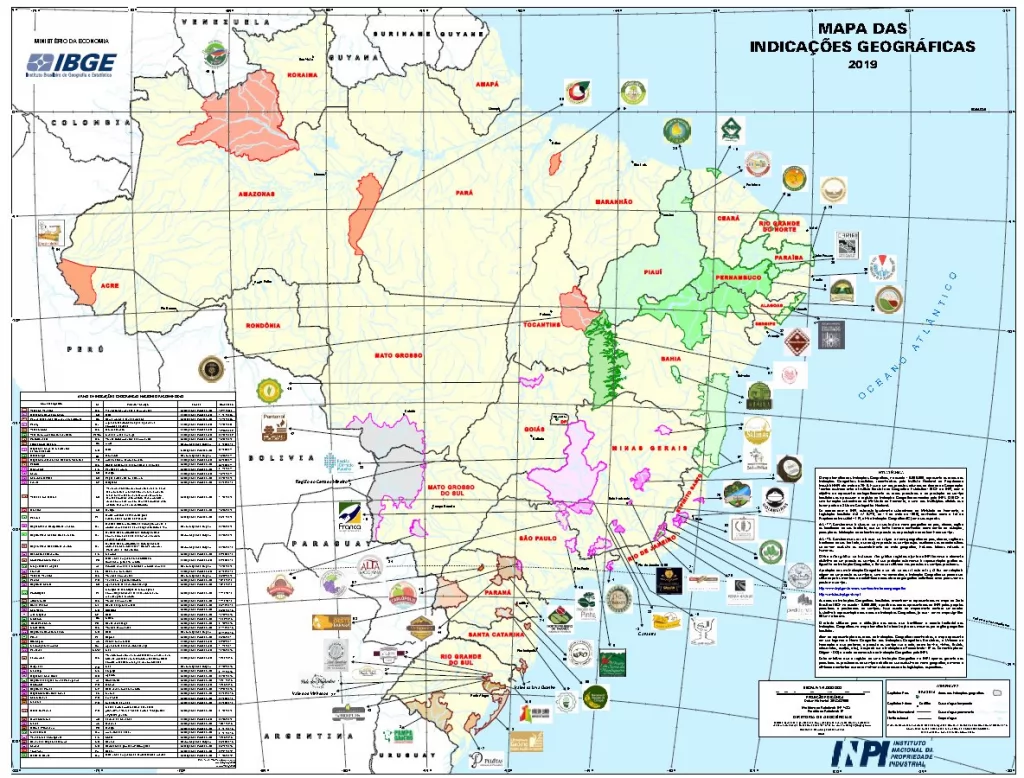
The Brazilian Institute of Geography and Statistics (IBGE) launched the new version of the Map of Geographical Indications of Brazil on Thursday, September 20th. Updated, the digital map presents the territories that have Geographical Indication (GI) certification, created in 1996 to protect products and services whose qualities are linked to their origin. The map was developed in partnership with the National Institute of Industrial Property (INPI), the agency responsible for certification, and aims to guide and provide assurances to consumers about the origin of the 49 national products and services that have certification.
In its legend, the map also provides information such as the geographical name of Brazilian GIs, the state to which each one belongs, the product or service (coffee, beef, wines, textiles, handicrafts, cheeses, among others), the date of certification by INPI, and the type of certification – whether it is Indication of Provenance (IP) or Designation of Origin (DO). The map includes some well-known areas, such as the Vale dos Vinhedos in the South, known for its wine production; the Serra da Canastra in Minas, known for its cheeses; Paraty in Rio, known for its cachaças; and the Pampas in Rio Grande do Sul, known for meat production.
Today, in Brazil, there are 49 areas certified with the GI seal, distributed throughout all regions of the country and divided into two categories: 40 areas with the Indication of Provenance (IP) seal and 9 areas with the Designation of Origin (DO) seal – see below for the difference between the two.
In 2014, Paladar created its own map with regions certified by INPI. At that time, there were 41 territories with the GI seal. Since then, nine more areas have gained certification, including eight related to food or beverages. The latest product to receive Geographical Indication was coffee from the Pinhal region, on the border between the states of São Paulo and Minas Gerais, in August of this year.
The Vale dos Vinhedos has been recognized as a Designation of Origin since 2012 – the first for wines in the country.
What is Geographical Indication? Geographical Indication (GI) is a form of protection for products and services with a specific origin. Think of Parma ham, French champagne, and Port wine: certain products have gained worldwide fame for their quality and have been imitated. To ensure that they were indeed authentic, official forms of origin recognition related to a specific territory were created. In Brazil, GI was established in 1996 (in the context of intellectual property trade agreements). This is why GI is granted by the National Institute of Industrial Property (INPI), which is also responsible for trademark and patent protection.
The certification has two categories: Designation of Origin (DO) and Indication of Provenance (IP). Unlike other countries, Brazil also grants GIs to non-agri-food products.
IP recognizes the reputation of a geographical name in the production of a service or product. It has fewer requirements – and is therefore more common in the country – than DO. DO refers to a service or product whose qualities are due exclusively or essentially to the geographical environment, including natural and human factors. GI has no expiration date. It is the associations of producers themselves that are responsible for monitoring whether the registration is being properly used.
See the Map in a pdf version here —> indicacoes_geograficas_2019_20190919